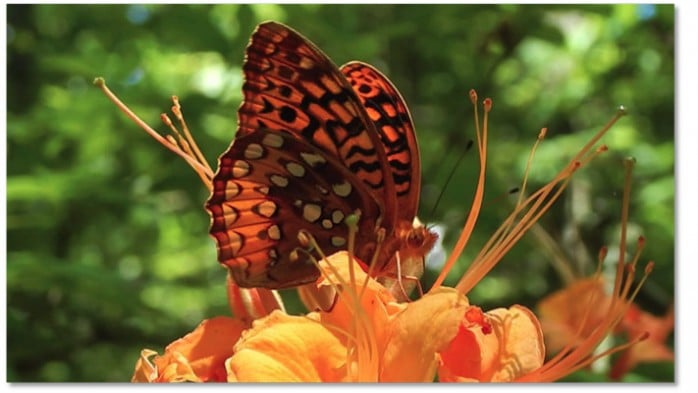The Butterfly Effect: Insect’s Wings Key to Azalea Pollination

A researcher from North Carolina State University has found that in the case of the flame azalea (Rhododendron calendulaceum), all pollinators are not created equal. In fact, due to the flower’s unique reproductive structure, butterflies – and specifically, their wings – are the key to pollination.
The flame azalea is commonly found in the Appalachian Mountains, ranging from as far north as New York to Georgia in the south. Like most azaleas, the flowers are large, and have an unusual structure: both the anther (male) and stigma (female) parts are very elongated and separated from one another.
NC State biologist Mary Jane Epps was interested in how the azalea’s flower structure affected its pollination. “In order for a plant to reproduce, a pollinator – usually an insect – has to spread the pollen from the anther to the stigma,” Epps says. “In the case of the flame azalea, the distance between these two structures meant that it was unlikely for a bee or other small pollinator to come into contact with both anther and stigma during a visit.”
Butterflies, on the other hand, are much larger than other pollinators, and they also frequent azaleas. Epps, along with biologists Suzanne Allison from James Madison University and Lorne Wolfe from the University of KwaZulu-Natal, South Africa, had noticed that only butterflies seemed to come into contact with both anther and stigma when visiting azaleas, so they set out to discover whether there was a connection when it came to pollinating the flame azalea. The biologists set up three different treatments among the azaleas: excluding all pollinators; excluding butterflies but allowing smaller pollinators like bees or flies access to the flowers; or leaving the flowers open to every insect, and tracked the pollination process.
They found very low rates of pollination for the plants in cases where all pollinators were excluded or only butterflies were excluded. But when the azaleas were exposed to all pollinators, including butterflies, pollination rates were higher by a magnitude of 10.
The researchers discovered something else interesting – the pollen was most likely being transferred by the butterflies’ wings, instead of their bodies. “We observed two species of butterfly that frequented these flowers: the eastern tiger swallowtail and the great spangled fritillary. However, the majority of the butterflies were the swallowtails, who differ from the fritillaries because they tend to keep moving their wings even when gathering nectar from a flower,” Epps says. “The constant fanning motion gives the wings a number of contacts with both anther and stigma, making the swallowtails more efficient at pollination.”
Microscopic examination of the tiger swallowtails’ wings confirmed that, in fact, the insects did carry a significant amount of pollen on their wings – 57 times more than on their bodies. “When we think of pollination, we typically think that the insects are carrying the pollen on their bodies,” Epps says. “But here we see that in the case of these butterflies on flame azaleas, the wings are actually more important, as they’re the part of the insect that most frequently makes contact with both anther and stigma.”
The findings also suggest that some plants may be dependent on very few insect species for pollination, even when many species visit the flowers and contact the male or female flower parts, but not necessarily both, as the butterflies did in this case. “We know that generally speaking, pollinator populations are in decline,” Epps says. “So it’s important that we find out how dependent plants are on specific pollinators, in order to preserve and protect plant species.”
The researchers’ work appears in American Naturalist. Research was conducted at Mountain Lake Biological Station, and was funded by grants from the National Science Foundation, the Margaret Walton Scholarship, and the John’s Creek Endowment Fund.
-peake-
Note to editors: Abstract follows.
“Reproduction in flame azalea (Rhododendron calendulaceum, E 1 ricaceae): A rare case of insect wing pollination”
DOI: 10.1086/682006
Authors: Mary Jane Epps, North Carolina State University; Suzanne Allison, James Madison University; Lorne Wolfe, University of KwaZulu-Natal, South Africa
Published: Online May 19, 2015 in American Naturalist
Abstract:
Although many angiosperms are serviced by flying pollinators, reports of wings as pollen vectors are rare. Flame azalea (Rhododendron calendulaceum) is visited by diverse insects, yet previous observations suggested that only butterfly wings may transfer pollen to stigmas. We used an experimental approach to determine if butterfly wings are the primary vehicle of pollination in flame azalea. Over two seasons of observations, only butterflies (Papilio glaucus and Speyeria cybele) contacted both anthers and stigmas, yet due to differences in wing-flapping behavior, P. glaucus transferred pollen most efficiently. In contrast, bee species specialized either on pollen or nectar, but did not contact both anthers and stigmas. A field experiment revealed that flowers excluding butterflies experienced almost complete fruit failure, whereas fruit set in open flowers did not differ from those that were hand-pollinated. Additionally, butterflies had 56-fold more azalea pollen on their wings than bodies, while azalea stigmas bore both pollen and wing scales. These results suggest that plants with many visitors contacting reproductive organs may still specialize on a single guild of visitors for pollination, and that wing-borne pollen transfer is a key mode of flame azalea pollination.
- Categories:


